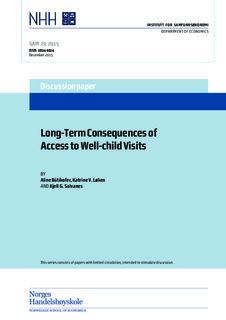Long-Term Consequences of Access to Well-child Visits.
Working paper

Åpne
Permanent lenke
http://hdl.handle.net/11250/2366609Utgivelsesdato
2015-12-02Metadata
Vis full innførselSamlinger
- Discussion papers (SAM) [657]
Sammendrag
A growing literature documents the positive long-term effects of policy-induced improvements in early-life health and nutrition. However, there is still scarce evidence on early-life health programs targeting a large share of the population and the role of such programs in increasing intergenerational mobility. This paper uses the rollout of mother and child health care centers in Norway, which commenced in the 1930s, to study the long-term consequences of increasing access to well-child visits. These well-child visits included a physical examination and the provision of information about adequate infant nutrition. Our results indicate that access to mother and child health care centers had a positive effect on education and earnings: access in the first year of life increased the completed years of schooling by 0.15 years and earnings by two percent. The effects were stronger for children from a low socioeconomic background. In
addition, we find that individuals suffer from fewer health risks at age 40 and positive effects on adult height, which support the fact that better nutrition within the first year of life is the likely mechanism behind our findings. While there is increasing knowledge on the benefits of various types of early childhood programs, the costs are often neglected, making it hard to compare different programs. We add to this by showing that investments in mother and child health care centers pass a simple cost-benefit analysis.